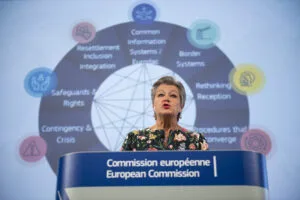Brussels – With the entry into force of the Migration and Asylum Pact (although actual implementation will take two years) and the adoption of the Common Implementation Plan, member states have entered the phase of implementing common migration and asylum legislation, with a deadline of December 12 in sight for the submission of each national implementation plan. It is for this reason that the EU executive has made available a Technical Support Facility dedicated precisely to customized support and technical advice for the 26 countries involved (after Ireland decided to join the common system, only Denmark is making use of the opt-out option), which nine capitals, including Rome, will make use of.

After the approval process of the pact that lasted an entire legislature and its entry into force on June 11, the von der Leyen cabinet defined in the joint implementation plan the 10 interdependent building blocks (or ‘blocks’) to implement to enable the proper functioning of a very complex piece of legislation. However, the real work lies with the single countries because – even before the December 12 deadline – member states have to submit drafts of their national implementation in October to receive support in time from the Commission. Then, they must submit national contingency plans by April 2025, and July 1, 2025, will be the deadline for establishing national coordination structures and appointing the national coordinator. Within this framework, the EU executive opened a dedicated call for proposals in June to assist member states in preparing their national implementation plans, offering targeted support on situation analysis and actions needed to implement the Migration and Asylum Pact.
Nine member countries responded to the EU Commission’s offer – Belgium, Estonia, Germany, Greece, Ireland, Italy, Portugal, the Czech Republic, and Romania. They will now receive tailored advice for four months (until the end of November) from experts in national legal frameworks and with knowledge of relevant practices in other countries. The goal will be to identify areas where there is a need for an update of national legislation and an overhaul of administrative and judicial processes, including considering staffing, infrastructure, information technology, cost, and procurement needs. The EU Commission will support Italy in 8 out of 10 thematic blocks, all except Block 1 (‘Common Information System on Migration and Asylum: EURODAC’) and Block 7 (‘Making Solidarity Work’). As the EU Commission explains, focus will be on the legislative reforms needed in accountability – “on the analysis of the current structure of the Dublin Unit and its organization and staffing.” For Horizontal issues, the support will focus on ensuring free legal advice, alternatives to detention, representation, and protection of unaccompanied minors, and the establishment of an independent mechanism for monitoring fundamental rights.
The basis of the Migration and Asylum Pact
The new Migration and Asylum Pact system (here is the explanation in detail) is based on the relationship between solidarity and responsibility in managing migrants among the 27 member states. This concept permeates the Regulation for the Management of Asylum and Migration (RAMM), which in no way overrides the cardinal principle of the 2013 Dublin Regulation, namely that the task of examining the asylum claim of a person who irregularly enters EU territory rests with the EU member state of first arrival. Countries like Italy, Greece, Malta, Cyprus, and Spain will be responsible for applications, while other member states that want to ‘Dublin’ (i.e., extradite) these migrants – including minors and those applying for reunification with siblings – will have to send a notification, no longer a reciprocal due process request with the agreement of the country of first arrival, as is the case today. After the Regulation enters into force – 24 months after its publication in the EU Official Journal – the now-famous mandatory solidarity mechanism for all Twenty-Seven (based on GDP and population) will kick in, equalizing the three forms of solidarity: relocations of migrants, financial contributions, or support to third countries. Contributions to member countries can go to reception systems and funding of fixed and mobile border facilities through the Border and Visa Management Instrument (BMVI) and the Asylum, Migration, and Integration Fund (AMIF). There will be no mandatory relocation for migrants disembarked after search and rescue operations at sea, and. for those under the Ramm procedure, there is no legal representation, just counseling.
 The concept of accountability mostly relates to the Asylum Procedures Regulation (APR) and increases only those provided for countries of first entry. It will automatically apply if there is a risk for security threat issues – including unaccompanied minors – of “deception of authorities” or if the migrant comes from a country with a recognition rate of less than 20 percent. Border procedures will provide de facto detention, with no exemptions even for families with children under 12, nor legal representation, nor a stay for appeals against most decisions (the exception is for inadmissibility of those based on the concept of “safe third country” and for unaccompanied minors). The “Safe Third Country” concept is crucial to this Regulation, with EU and national lists provided to justify and expedite rapid returns out of the Union unless there are links between the individual person and the state from where they come that preclude their safety. New accountability obligations include completing the examination of an asylum application through the border procedure within six months (APR), extending the period of responsibility for handling applications for 20 months, and still at 12 months for search and rescue operations at sea (RAMM). The annual ceiling for border procedures is 30,000 people, based on a formula that considers the number of irregular border crossings and expulsions in the previous three years.
The concept of accountability mostly relates to the Asylum Procedures Regulation (APR) and increases only those provided for countries of first entry. It will automatically apply if there is a risk for security threat issues – including unaccompanied minors – of “deception of authorities” or if the migrant comes from a country with a recognition rate of less than 20 percent. Border procedures will provide de facto detention, with no exemptions even for families with children under 12, nor legal representation, nor a stay for appeals against most decisions (the exception is for inadmissibility of those based on the concept of “safe third country” and for unaccompanied minors). The “Safe Third Country” concept is crucial to this Regulation, with EU and national lists provided to justify and expedite rapid returns out of the Union unless there are links between the individual person and the state from where they come that preclude their safety. New accountability obligations include completing the examination of an asylum application through the border procedure within six months (APR), extending the period of responsibility for handling applications for 20 months, and still at 12 months for search and rescue operations at sea (RAMM). The annual ceiling for border procedures is 30,000 people, based on a formula that considers the number of irregular border crossings and expulsions in the previous three years.











